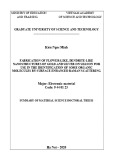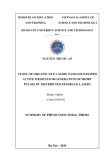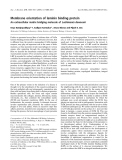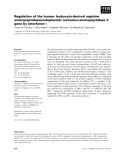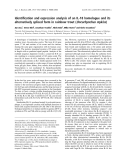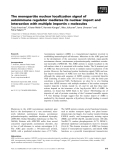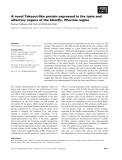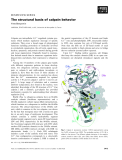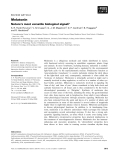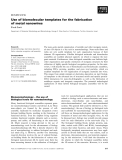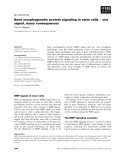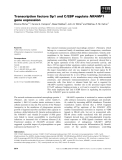
Organic molecules
-
A reaction happens need the energy to vibrate the molecules and the reactant concentration enough. The energy here is often provided by heat. However, in living system, high temperature may harm the biological structure Truly that the concentration in living system is very low. So living organisms solve these problems by using enzyme
 94p
94p  zingzing09
zingzing09
 21-10-2012
21-10-2012
 68
68
 10
10
 Download
Download
-
The objective of this project was to develop \(Ti{O_2}\) based multifunctional substrates through silver decoration, while simultaneously enhancing the photocatalytic performance of \(Ti{O_2}\) in the substrate. Employing Ag nanoparticles introduced additional functionality to the system, namely surface-enhanced Raman scattering (SERS), thus enabling the detection of trace amounts of organic molecules prior to their degradation, all with the same substrate.
 123p
123p  runthenight04
runthenight04
 02-02-2023
02-02-2023
 10
10
 2
2
 Download
Download
-
In this thesis, we research and fabricate AgNDs, AgNFs, AuNFs structures on silicon by chemical deposition and electrochemical deposition method for the main purpose of using as SERS substrate. To this target, we have studied the morphology, structure and some properties of the nanostructures produced.
 26p
26p  extraenglish
extraenglish
 24-05-2021
24-05-2021
 31
31
 4
4
 Download
Download
-
In this thesis, we research and fabricate AgNDs, AgNFs, AuNFs structures on silicon by chemical deposition and electrochemical deposition method for the main purpose of using as SERS substrate. To this target, we have studied the morphology, structure and some properties of the nanostructures produced.
 26p
26p  capheviahe27
capheviahe27
 23-02-2021
23-02-2021
 35
35
 4
4
 Download
Download
-
Research purpose: Preparation and characterization of GNPs-doped active medium based on dye molecules in PMMA applied to generate short pulses in the range of pico-seconds by using distributed feedback dye lases (DFDL) configuration are aimed.
 27p
27p  xacxuoc4321
xacxuoc4321
 08-07-2019
08-07-2019
 42
42
 5
5
 Download
Download
-
Earlier we presented several lines of evidence that a 67-kDa laminin binding protein (LBP) inLeishmania donovani,that is different from the putative mammalian 67-kDa laminin receptor, may play an important role in the onset of leish-maniasis, as these parasites invade macrophages in various organs after migrating through the extracellular matrix. Here we describe the membrane orientation of thisLeish-manialaminin receptor.
 8p
8p  tumor12
tumor12
 20-04-2013
20-04-2013
 46
46
 4
4
 Download
Download
-
The leukocyte-derived arginine aminopeptidase (L-RAP) is the second ami-nopeptidase localized in the endoplasmic reticulum (ER) processing anti-genic peptides presented to major histocompatibility complex (MHC) class I molecules. In this study, the genomic organization of the gene encoding human L-RAP was determined and the regulatory mechanism of its expres-sion was elucidated.
 13p
13p  awards
awards
 05-04-2013
05-04-2013
 57
57
 5
5
 Download
Download
-
A homologue of interleukin 18 has been identified from rainbow trout,Oncorhynchus mykiss. The trout IL-18gene spans 3.7 kb and consists of six exons and five introns, sharing the same gene organization with its human coun-terpart. The putative translated protein is 199 amino acids in length with no predicted signal peptide. Analysis of the multiple sequence alignment reveals a conserved ICE cut site, resulting in a mature peptide of 162 amino acids. The trout IL-18 shares 41–45% similarity with known IL-18 molecules and contains an IL-1 family signature motif....
 11p
11p  dell39
dell39
 03-04-2013
03-04-2013
 54
54
 3
3
 Download
Download
-
Autoimmune regulator (AIRE) is a transcriptional regulator involved in establishing immunological self-tolerance. Mutations in theAIREgene lead to the development of the autosomal, recessively inherited, organ-specific autoimmune disease, autoimmune polyendocrinopathy candidiasis ectoder-mal dystrophy (APECED).
 10p
10p  dell39
dell39
 27-03-2013
27-03-2013
 40
40
 2
2
 Download
Download
-
In insects, the functional molecules responsible for the taste system are still obscure. The gene for a 28.5 kDa protein purified from taste sensilla of the blowflyPhormia reginabelongs to a gene family that includestakeout of Drosophila melanogaster. Molecular phylogenetic analysis revealed that the PhormiaTakeout-like protein is most similar to the protein encoded by a member of theDrosophila takeoutgene family, CG14661, whose expression and function have not been identified yet.
 11p
11p  inspiron33
inspiron33
 25-03-2013
25-03-2013
 45
45
 5
5
 Download
Download
-
Calpains are intracellular Ca 2+ -regulated cysteine pro-teases which mediate regulatory cleavage of specific substrates. They cover a broad range of physiological functions including proteolysis of molecules involved in cytoskeletal organization, the cell cycle, signal trans-duction, apoptosis, and protein renewal during growth and tissue regeneration. Originally found in mamma-lian skeletal muscle then in numerous organisms inclu-ding protists and plants, their expression is ubiquitous [1,2].
 2p
2p  inspiron33
inspiron33
 25-03-2013
25-03-2013
 42
42
 4
4
 Download
Download
-
Melatonin is a ubiquitous molecule and widely distributed in nature, with functional activity occurring in unicellular organisms, plants, fungi and animals. In most vertebrates, including humans, melatonin is synthes-ized primarily in the pineal gland and is regulated by the environmental light⁄dark cycle via the suprachiasmatic nucleus.
 26p
26p  inspiron33
inspiron33
 25-03-2013
25-03-2013
 40
40
 4
4
 Download
Download
-
The nano-scale spatial organization of metallic and other inorganic materi-als into 1D objects is a key task in nanotechnology. Nano-scale fibers and tubes are very useful templates for such organization because of their inherent 1D organization. Fibrillar biological molecules and biomolecular assemblies are excellent physical supports on which to organize the inor-ganic material.
 6p
6p  inspiron33
inspiron33
 23-03-2013
23-03-2013
 46
46
 4
4
 Download
Download
-
Báo cáo khoa học: Bone morphogenetic protein signaling in stem cells ) one signal, many consequences
Bone morphogenetic protein (BMP) signals play key roles throughout embryology, from the earliest patterning events, via tissue specification, through organ development and again in germ cell differentiation. While both input and the transducer molecules are rather well studied, the final outcome of a BMP signal is basically unpredictable and differs enormously between previously studied cell types.
 9p
9p  galaxyss3
galaxyss3
 19-03-2013
19-03-2013
 63
63
 4
4
 Download
Download
-
NAD is an important cofactor and essential molecule in all living organ-isms. In many eubacteria, including several pathogens, the first two steps in the de novosynthesis of NAD are catalyzed byl-aspartate oxidase (NadB) and quinolinate synthase (NadA). Despite the important role played by these two enzymes in NAD metabolism, many of their biochemical and structural properties are still largely unknown.
 16p
16p  vinaphone15
vinaphone15
 28-02-2013
28-02-2013
 41
41
 4
4
 Download
Download
-
Antimicrobial peptides constitute one of the main classes of molecular weapons deployed by the innate immune system of all multicellular organisms to resist microbial invasion. A good proportion of all antimi-crobial peptides currently known, numbering hundreds of molecules, have been isolated from frog skin.
 18p
18p  viettel02
viettel02
 20-02-2013
20-02-2013
 32
32
 3
3
 Download
Download
-
Diterpenes are a structurally diverse class of molecules common in plants, although they are very rarely found in bacteria. We report the identifica-tion in Mycobacterium tuberculosis(Mtb) of three diterpenes proposed to promote phagolysosome maturation arrest. MS analysis reveals that these diterpenes are novel compounds not previously identified in other organ-isms.
 8p
8p  viettel02
viettel02
 19-02-2013
19-02-2013
 41
41
 3
3
 Download
Download
-
Special Topics I. Selenium Ecotoxicology II. Arsenic in Drinking Water Principles of Environmental Toxicology Instructor: Gregory Möller, Ph.D. University of Idaho. Examine the chemistry of selenium in inorganic and organic molecules. Understand the role of seleno-amino acids in the expression of selenium toxicity in plant and animal systems. Examine chronic selenium toxicosis (selenosis). Understand the role of selenium in reproductive failure.
 11p
11p  nguyenvanquan037
nguyenvanquan037
 07-01-2011
07-01-2011
 93
93
 10
10
 Download
Download
CHỦ ĐỀ BẠN MUỐN TÌM










